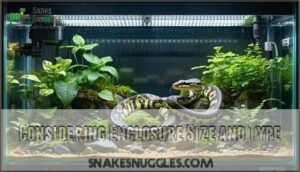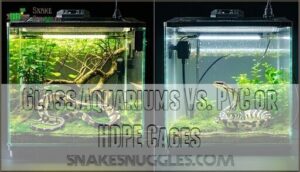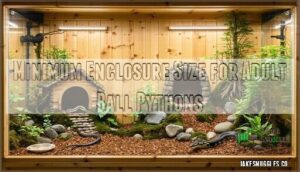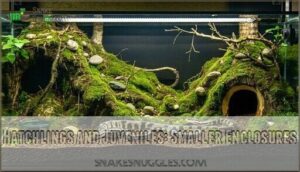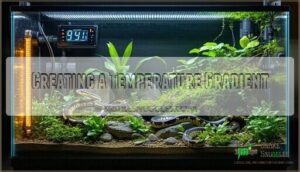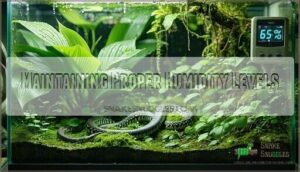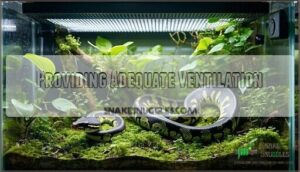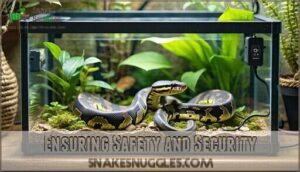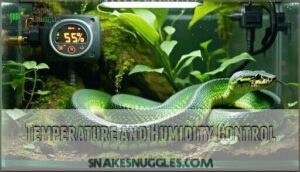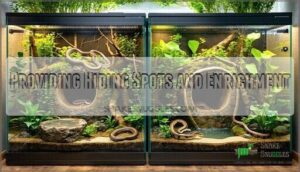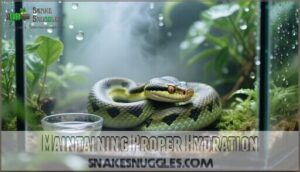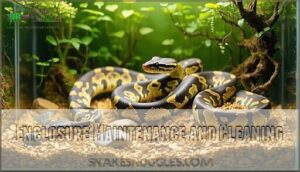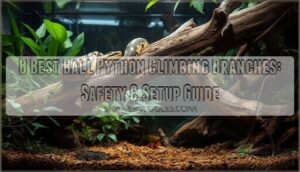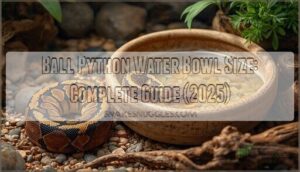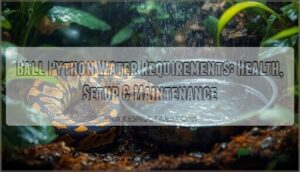This site is supported by our readers. We may earn a commission, at no cost to you, if you purchase through links.
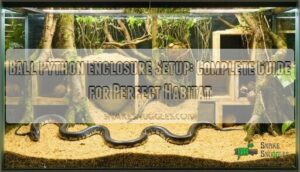 Perfect ball python enclosure setup starts with a 4x2x2 feet PVC cage that retains heat better than glass tanks.
Perfect ball python enclosure setup starts with a 4x2x2 feet PVC cage that retains heat better than glass tanks.
You’ll need a thermal gradient from 88-92°F on the basking side to 76-80°F on the cool side, with 50-60% humidity maintained through coconut fiber or cypress mulch substrate.
Skip cedar and pine – they’re toxic to snakes.
Place hide boxes on both warm and cool sides, add a central water bowl, and include climbing branches for enrichment.
Monitor everything with digital thermometers and hygrometers, checking calibration monthly.
The substrate choice alone can make or break your humidity control.
Table Of Contents
- Key Takeaways
- Choosing The Right Enclosure
- Setting Up The Enclosure Environment
- Substrate: The Floor of Your Snake’s World
- Temperature and Humidity Control
- Lighting and Visual Stimulation
- Providing Hiding Spots and Enrichment
- Maintaining Proper Hydration
- Enclosure Maintenance and Cleaning
- Enclosure Design and Layout
- Frequently Asked Questions (FAQs)
- How do you set up a ball python enclosure?
- How do I set up a ball python habitat?
- What are the essential components of a ball python habitat setup?
- How do you set up a Python enclosure?
- How Often Should I Clean My Ball Python’s Enclosure?
- What is the Best Way to Feed My Ball Python?
- How Often Should I Handle My Ball Python?
- What Plants Are Safe to Have in a Ball Python Enclosure?
- Are Ball Pythons Vocal?
- What should a ball python have in its enclosure?
- Conclusion
Key Takeaways
- Size your enclosure properly – You’ll need a minimum 4x2x2 feet PVC cage for adult ball pythons, as this provides adequate space for movement and proper thermal regulation while retaining heat better than glass tanks.
- Create the right temperature gradient – Set up your basking side at 88-92°F and cool side at 76-80°F using thermostats and digital monitoring, as this thermal gradient is essential for your python’s digestion and overall health.
- Choose substrate wisely – Use coconut fiber or cypress mulch for optimal humidity retention while avoiding toxic cedar or pine shavings that can harm your snake’s respiratory system and liver function.
- Provide essential hiding spots and maintain humidity – Install secure hide boxes on both warm and cool sides while maintaining 50-60% humidity through proper substrate moisture and ventilation to prevent shedding problems and respiratory infections.
Choosing The Right Enclosure
Selecting the right enclosure forms the foundation of successful ball python care, directly impacting your snake’s health and behavior.
You’ll need to evaluate size requirements, material options, and your python’s current age to create an ideal living space that supports your snake’s overall behavior.
Considering Enclosure Size and Type
When selecting your ball python’s home, prioritize adequate enclosure size and durable enclosure materials.
Your snake’s adult length determines space requirements—adults need minimum 4x2x2 feet for proper movement and thermoregulation.
Consider these key factors:
- Tank size: Match enclosure dimensions to your python’s full-grown length
- Ventilation needs: Balance airflow with humidity retention for ideal health
- Material durability: Choose materials that withstand high humidity and frequent cleaning
Proper reptile enclosure size prevents stress and promotes natural behaviors in your ball python.
Many resources are available for selecting python enclosures.
Glass Aquariums Vs. PVC or HDPE Cages
Two main enclosure types dominate the market: glass tanks and PVC enclosures.
Glass enclosures excel in visibility but struggle with heat retention and add significant weight.
PVC enclosures offer superior heat retention, reduced material costs over time, and extensive customization options.
Plastic cages maintain humidity effectively while glass tanks require more heating adjustments, making your weight comparison and long-term goals key factors.
Proper ventilation is essential for maintaining air circulation.
Minimum Enclosure Size for Adult Ball Pythons
Adult ball python enclosure size requirements are straightforward yet critical for proper snake care.
Your adult ball python needs a minimum 4x2x2 feet enclosure (48"x24"x24") to thrive.
Here are the essential ball python enclosure size requirements:
- Adult Dimensions: 4 feet long minimum for proper movement and stretching
- Space Utilization: Floor space matters more than height for ground-dwelling behavior
- Enrichment Needs: Larger enclosures accommodate multiple hides and climbing structures
- Behavioral Impacts: Cramped conditions increase stress and defensive postures
- Upgrade Frequency: Size up by year three when snakes reach adult length
This python tank size provides adequate thermal gradient zones while preventing stress-related health issues.
You can find various enclosure products online to suit your snake’s needs.
Hatchlings and Juveniles: Smaller Enclosures
When starting with hatchlings and juveniles, think "small and secure" for your ball python enclosure setup.
Baby python enclosures need careful sizing to reduce stress and improve feeding access.
Here’s your hatchling enclosure size guide:
- 10-gallon tanks work perfectly for hatchlings under 6 months old
- 20-gallon upgrades suit juveniles as they grow toward adult size
- Escape-proof lids prevent dangerous escapes and maintain proper ball python habitat conditions.
You can find suitable python enclosure products online.
Setting Up The Enclosure Environment
Once you’ve selected your enclosure, you’ll need to create the right environmental conditions for your ball python’s health and comfort.
This involves establishing proper temperature gradients, humidity levels, ventilation, and security measures that mimic their natural habitat requirements, including the need for proper ventilation.
Creating a Temperature Gradient
Position your heat source on one end to create the essential temperature gradient your ball python needs.
Install a thermostat to maintain your basking spot at 88-92°F while keeping the cool side at 78-80°F.
Use digital thermometers for accurate gradient measurement and adjust heating settings seasonally to guarantee proper temperature regulation throughout the year.
Maintaining Proper Humidity Levels
Why is humidity control so critical for your ball python’s health? Maintaining 50-60% relative humidity prevents respiratory infections and shedding issues that can plague these sensitive reptiles.
Here are four essential humidity control methods for your ball python enclosure:
- Install a digital hygrometer – Monitor humidity levels accurately rather than guessing
- Use moisture-retaining substrate – Sphagnum moss and cypress mulch naturally boost humidity
- Strategic water bowl placement – Position larger bowls on the warm side to increase evaporation
- Implement controlled misting – Light misting 2-3 times weekly maintains consistent levels
You don’t need daily misting marathons to achieve proper humidity control. A reliable humidifier can maintain consistent levels without constant intervention. Focus on hydration methods that work with your schedule, not against it. Poor humidity monitoring leads to stuck sheds and respiratory problems that’ll have you rushing to the vet. Smart humidity control means less maintenance and healthier snakes.
Providing Adequate Ventilation
Proper enclosure ventilation creates the foundation for your ball python’s respiratory health.
Strategic airflow prevents dangerous mold growth while maintaining essential humidity levels.
Here’s your ventilation checklist:
- Install mesh screen tops – These provide consistent air exchange without compromising temperature gradients or humidity control.
- Position ventilation openings strategically – Place air gaps near the warm and cool sides to promote natural airflow circulation throughout the snake enclosure.
- Monitor for mold prevention – Check corners and substrate regularly, as proper aeration prevents moisture buildup that leads to harmful bacterial growth.
Ensuring Safety and Security
Beyond simple containment, snake enclosure security demands rigorous attention to escape prevention and electrical safety.
You’ll need latching lids that can’t be pushed open, non-toxic materials throughout, and proper supervision during handling sessions to minimize snake stress.
| Safety Feature | Implementation |
|---|---|
| Secure Lid | Install heavy-duty latching mechanisms with clips |
| Escape Prevention | Check all gaps; guarantee no openings exceed snake diameter |
| Electrical Safety | Use GFCI outlets and thermostat-controlled heating elements |
| Non-toxic Materials | Select substrate and décor free from harmful chemicals |
| Handling Supervision | Never leave snake unattended outside secure enclosure |
Substrate: The Floor of Your Snake’s World
Your substrate choice creates the foundation for your ball python’s comfort and health.
The right material will maintain proper humidity levels while providing a safe, natural environment that supports your snake’s behavioral needs, which is crucial for its overall health.
Substrate Options for Ball Pythons
Your ball python substrate choice shapes your snake’s comfort and health.
Coconut fiber excels at humidity retention while supporting natural burrowing behaviors.
Aspen shavings offer excellent absorbency but require frequent mold prevention checks.
Cypress mulch provides superior moisture control with built-in antimicrobial properties.
Bioactive substrate mixes combine multiple materials for ideal substrate safety and long-term stability, though cost comparison favors simple paper-based options for budget-conscious keepers.
Avoiding Unrecommended Substrates
Choose substrate carefully to protect your snake’s health.
Some materials pose serious risks through aromatic oils or ingestion hazards.
- Cedar shavings: Contain toxic oils that cause respiratory irritation and liver damage
- Pine shavings: Release harmful aromatic compounds affecting snake health
- Sand dangers: Creates impaction risks when ingested during feeding
- Toxic substrates: Avoid anything treated with chemicals or artificial fragrances
To promote snake wellbeing, choose safe substrates like coconut fiber.
Substrate Depth and Burrowing
Set your substrate at 2-4 inches deep for ideal moisture retention without encouraging excessive burrowing behavior.
Coconut fiber and aspen shavings create naturalistic layers that maintain humidity gradients while preventing substrate compaction.
This depth allows your python to nestle comfortably without the substrate becoming waterlogged.
The loose texture mimics forest floor conditions, giving your snake security without promoting digging habits that ball pythons don’t naturally exhibit in captivity.
Humidity Retention and Substrate Moisture
Substrate Choice directly impacts your ball python’s humidity control. The right materials help maintain 50-60% humidity levels while preventing mold growth.
Your moisture management strategy should include:
- Sphagnum moss or cypress mulch for superior water retention
- Coconut fiber mixed with dry substrate for balanced humidity monitoring
- Light misting frequency – weekly or when humidity drops below 50%
- Mold prevention through proper ventilation and substrate rotation
Proper substrate moisture supports shedding success without creating swampy conditions.
Temperature and Humidity Control
Temperature and humidity control forms the foundation of successful ball python keeping, directly impacting your snake’s health, feeding response, and shedding cycle.
You’ll need to establish a proper thermal gradient with the warm side at 88-92°F and cool side at 78-80°F, while maintaining humidity between 50-60% for ideal respiratory function and successful sheds.
Ball Python Habitat Temperatures: Thermal Gradient
Temperature regulation starts with creating your thermal gradient. Set your basking spot at 88-92°F using heat sources like under-tank heaters or ceramic emitters.
Keep the cool side between 76-80°F. Night temperatures shouldn’t drop below 75°F.
Install thermostat control to prevent dangerous spikes. Your ball python enclosure needs this gradient for proper digestion and health.
Temperature monitoring devices help track these zones accurately.
Temperature Monitoring: Digital Thermometer and Infrared Thermometer
Accurate temperature monitoring protects your ball python’s health through precise digital thermometer and infrared thermometer readings.
Digital thermometers provide quick, reliable ambient air temperatures, while infrared thermometers measure surface temperatures without contact.
Proper thermometer placement guarantees gradient verification across your enclosure.
- Peace of Mind: Know your snake’s environment stays perfectly controlled
- Health Insurance: Catch temperature problems before they affect your python
- Professional Setup: Monitor like experienced keepers with dual-thermometer accuracy comparison
Calibrate both devices monthly for maximum precision.
Place your digital thermometer on the cool side and use your infrared thermometer to check basking spots.
This thermostat integration approach guarantees consistent temperatures.
Humidity Requirements: 50-60% Relative Humidity
Maintaining proper humidity in your ball python enclosure isn’t rocket science, but it’s vital for your snake’s health.
You’ll need 50-60% relative humidity consistently throughout the habitat.
Humidity monitoring with a reliable hygrometer prevents shedding issues and satisfies your snake’s humidity requirements.
Enclosure misting with warm water helps raise levels when needed.
Choose moisture-retentive substrates to maintain stable conditions.
Watch for signs of dehydration or stuck shed – these indicate your humidity control needs adjustment.
| Method | Purpose |
|---|---|
| Digital hygrometer | Monitor humidity levels |
| Substrate misting | Increase moisture content |
| Water bowl placement | Natural humidity source |
Lighting and Visual Stimulation
Ball pythons don’t require complex lighting systems since they’re naturally nocturnal creatures that thrive in low-light conditions.
You’ll simply need to establish a consistent 12-hour light/dark cycle to maintain their natural circadian rhythm and support overall health.
Ball Python Habitat Lighting: Ambient Light is Sufficient
When setting up your ball python enclosure, basic ambient room lighting handles all your snake’s lighting needs perfectly.
Ball pythons don’t require specialized UV bulbs or intense light intensity since they’re naturally nocturnal.
Simple room lighting maintains their diurnal rhythm without stressing your snake.
This straightforward snake lighting setup keeps costs low while ensuring your ball python remains healthy and comfortable.
Full-Spectrum Lighting: Optional for Enhancing Appearance
Full spectrum lighting offers appearance enhancement through improved visual clarity of your ball python’s natural patterns.
While ambient light suffices, these specialized bulbs create richer color displays and support plant growth in bioactive setups.
Consider these lighting benefits:
- Enhanced snake coloration reveals stunning natural beauty
- Improved viewing experience during daily observations
- Support for live plants in naturalistic enclosures
- Better photography opportunities of your pet
- Creates a more engaging display environment
The light spectrum from full spectrum reptile lighting doesn’t require UVB bulbs for ball pythons.
Your lighting setup should focus on visual appeal rather than health requirements, making this an optional enhancement for your ball python enclosure lighting.
Light Cycle: 12-Hour Light/Dark Cycle
Your ball python’s lighting setup benefits from consistent cycles that mirror natural daynight cycles.
Establishing a 12-hour photoperiod benefits your snake’s biological rhythm without affecting their natural nocturnal behavior.
Timer automation eliminates guesswork and maintains reliable schedules even when you’re away.
Some keepers make seasonal adjustments to simulate natural changes, though stable cycles work perfectly.
Any basic light source works—you don’t need expensive equipment for effective lighting requirements in your ball python enclosure.
UV Radiation: Not Necessary for Ball Pythons
Unlike many reptiles, ball pythons don’t require UV radiation for peak health.
Your snake’s nocturnal nature means UVB unnecessary for their well-being, though some benefits exist for specific situations:
- Natural behavior patterns remain unaffected without UV exposure in your ball python enclosure
- Albinos sensitive to bright lighting actually prefer minimal UV light for comfort
- Plant growth requires UVB if you’re planning bioactive reptile lighting setups
Standard lighting setup provides adequate illumination without snake UV exposure concerns.
Providing Hiding Spots and Enrichment
Creating secure hiding spots and enrichment features is essential for your ball python’s psychological well-being and natural behavior patterns.
You’ll need at least two hide boxes—one on the warm side and one on the cool side—along with climbing branches, artificial plants, and a properly sized water dish to create a stimulating environment that reduces stress.
This environment is crucial for maintaining the health and happiness of your ball python, and providing these features is key to supporting its natural behavior patterns.
Essential Accessories: Hide Boxes, Water Dish, and More
Your ball python enclosure needs the right accessories to create a safe, comfortable habitat.
Secure Hides provide essential security – you’ll need one on each temperature zone.
A heavy Water Bowl prevents tipping and maintains humidity.
Feeding Tongs keep you safe during meals, while Climbing Decor adds enrichment without crowding your ball python enclosure.
- Secure Hides – Snug-fitting hideouts on warm and cool sides
- Water Bowl – Heavy, tip-resistant water dish sized appropriately
- Feeding Tongs – 12-inch tongs for safe feeding practices
- Climbing Decor – Sturdy branches or cork bark pieces
- Misting System – Optional spray bottle for humidity adjustments
Providing Variety and Enrichment: Hiding Places and Climbing Branches
Hides Importance can’t be overstated—multiple hideouts reduce stress by 70%.
Natural cork bark and coconut shells create Varied Textures your snake craves.
Climbing Benefits include improved shedding and 3x more exploration.
Secure branches properly; 18% of injuries come from loose perches.
Snake climbing structures boost muscle engagement.
Mix Enrichment Ideas like grapewood with artificial hides for easy cleaning.
Avoid clutter—strategic placement matters most.
Encouraging Exploration and Reducing Stress
Creating exploration opportunities reduces stress in your ball python enclosure.
Strategic placement of secure hides on both warm and cool sides provides essential retreats.
Safe climbing branches and enrichment items like cork rounds satisfy natural behaviors while maintaining stressfree environments.
Visual barriers help nervous snakes feel protected.
Regular rearrangement of cozy hiding spots prevents boredom and encourages natural exploration patterns throughout your snake enclosure design, promoting a natural and protected environment.
Avoiding Overcrowding and Adding Visual Appeal
Think of your ball python enclosure as a carefully balanced room—too much stuff creates stress, while thoughtful placement enhances comfort.
Strategic space utilization prevents overcrowding while maintaining visual appeal through well-chosen enrichment items.
- Use visual barriers like plastic plants to create natural hiding variety without cluttering
- Position enclosure accessories along walls to maximize open floor space for movement
- Select live plants or realistic decorations that serve dual purposes as both snake habitat decoration and functional elements
Clutter reduction keeps your ball python enclosure functional while strategic decoration creates an engaging environment, enhancing visual appeal and promoting a sense of natural hiding, all of which contribute to a better ball python enclosure.
Maintaining Proper Hydration
Proper hydration keeps your ball python healthy and supports successful shedding cycles. You’ll need to maintain both direct water access and ideal humidity levels to prevent dehydration-related health issues.
Water Bowl Placement and Accessibility
Position your water dish centrally in the ball python enclosure for easy access from both warm and cool sides.
Choose appropriate bowl size – large enough for soaking but not overwhelming your snake. Heavy ceramic or glass bowl material prevents tipping and spillage prevention.
Replace water weekly or when soiled for ideal cleaning frequency. Some keepers use multiple bowls for larger enclosures.
These snake enclosure accessories support proper snake hydration and are essential snake habitat accessories.
Humidity and Hydration: Facilitating Shedding and Hydration
Proper ball python humidity directly impacts your snake’s ability to shed successfully. Maintaining 55-65% humidity prevents shedding problems and supports overall health through effective hydration methods.
Monitor humidity levels with a reliable hygrometer and adjust through misting frequency and substrate moisture. Sphagnum moss in humid hides creates targeted high-humidity zones.
Here are three key benefits of ideal humidity control:
- Complete sheds – Your snake won’t struggle with stuck pieces
- Healthy skin – Proper hydration keeps scales supple and strong
- Stress reduction – Comfortable conditions mean a happier, calmer python
Water quality matters too – use dechlorinated water for both drinking and misting to avoid chemical irritation.
Signs of Dehydration: Difficulty Shedding and Dehydration
Beyond the obvious sunken eyes, watch for wrinkled scales and stuck sheds that won’t come off cleanly.
Your ball python may show lethargic behavior and produce tacky mucus around its mouth. These dehydration signs often coincide with poor snake shedding cycles.
Maintaining proper humidity control in your ball python enclosure prevents these issues from developing.
Owners should also watch for dry, cracked eye caps, which can also indicate dehydration.
Adjusting Humidity and Misting
Several methods guarantee proper humidity control for your ball python’s health.
Regular humidity monitoring with a digital hygrometer maintains ideal 50-60% levels.
- Misting frequency: Spray enclosure 2-3 times weekly, adjusting based on seasonal changes
- Hydration methods: Increase water bowl size or add second dish for natural evaporation
- Shedding assistance: Boost humidity to 70% during pre-shed periods for complete skin removal
- Mold prevention: Guarantee proper ventilation while maintaining moisture for snake humidity regulation
Enclosure Maintenance and Cleaning
Maintaining a clean enclosure is essential for your ball python’s health and prevents bacterial growth that can lead to infections.
You’ll need to establish a regular cleaning routine that includes spot-cleaning waste, replacing substrate, and disinfecting surfaces to create a safe environment for your snake.
Regularly Cleaning and Disinfecting The Enclosure
Routine enclosure cleaning safeguards your ball python’s health through pathogen reduction and environmental control. Studies show proper sanitation lowers bacterial loads by 91% while preventing respiratory infections.
Ensuring proper airflow is also essential for a healthy environment, so consider strategic screen placement.
Schedule full disinfection every 2-4 weeks using chlorhexidine or F10 solutions:
- Substrate replacement – Remove all bedding during deep cleans to prevent fungal outbreaks
- Water bowl hygiene – Disinfect twice weekly, maintaining fresh water sources
- Enclosure disinfection – Apply solutions for 10 minutes, then rinse thoroughly
- Snake enclosure maintenance – Use dedicated cleaning tools per habitat
- Preventing mold – Address organic debris within 4 days in high-humidity environments
Removing Waste and Uneaten Food Promptly
Daily waste identification and removal prevents bacterial growth and odor control issues.
Check for shed skin fragments and uneaten prey items after feeding sessions. Use sanitized tools for waste removal to support parasite mitigation efforts.
Spot-clean affected substrate areas immediately to maintain ideal enclosure maintenance standards and prevent contamination spread.
Remove waste
Spot-clean area
Sanitize tools
Replacing Soiled Substrate Regularly
Substrate maintenance becomes your snake’s health foundation. Replace soiled areas immediately through Spot Cleaning when waste appears. Frequency Matters – perform Deep Cleaning monthly for complete ball python enclosure hygiene.
Follow these snake enclosure cleaning procedures:
- Remove contaminated substrate sections during Spot Cleaning sessions
- Conduct full Deep Clean monthly with complete substrate replacement
- Maintain proper Substrate Disposal to prevent contamination spread
- Maintain dry conditions for Mold Prevention in your enclosure maintenance routine
Fresh substrate prevents bacterial growth and maintains conditions that promote health.
Monitoring and Adjusting Temperature and Humidity
After cleaning your substrate, check your temperature regulation system with a digital thermometer on both warm and cool sides.
Thermostat calibration guarantees temperature stability year-round.
Monitor hygrometer accuracy to catch humidity spikes early.
Seasonal adjustments might require tweaking your humidifier settings to maintain ideal humidity levels.
Enclosure Design and Layout
Once you’ve tackled cleaning schedules, thoughtful enclosure design and layout transforms your ball python enclosure from basic housing into a thriving habitat.
Layout complexity matters—arrange elements to create distinct zones for basking, hiding, and exploring.
Your spatial arrangement should include multiple hiding spots positioned on both warm and cool sides, preventing stress while encouraging natural behaviors.
Strategic enrichment integration involves adding branches, artificial plants, or climbing structures that promote exercise without overwhelming the space.
Biophilic design principles work wonders for reptile enclosure design.
Consider naturalistic setups that mimic your python’s wild environment—think textured backgrounds, varied substrate depths, and strategically placed décor.
Snake habitat design succeeds when you balance functionality with enclosure aesthetics.
Position your water bowl away from heat sources to prevent excessive evaporation, and make certain all snake enclosure decoration remains secure and escape-proof.
Remember, your ball python doesn’t need a mansion—it needs a well-planned space where every element serves a purpose.
Frequently Asked Questions (FAQs)
How do you set up a ball python enclosure?
Choose size wisely, maintain temperatures precisely, provide hiding spots strategically.
You’ll need a 40-gallon tank minimum, 88-92°F warm side, 76-80°F cool side, secure substrate, water bowl, and dual hides, with strategically placed elements to ensure the well-being of the animals.
How do I set up a ball python habitat?
You’ll need a 40-gallon tank minimum for adults, heating to create 88-92°F basking spots, proper substrate, hiding places, water dish, and secure lid with ventilation.
What are the essential components of a ball python habitat setup?
You’ll need proper heating (88-92°F warm side, 76-80°F cool side), secure hides on both ends, water bowl, appropriate substrate, and reliable thermostats for temperature control.
How do you set up a Python enclosure?
Building your snake’s home is like creating a perfect studio apartment—every square inch matters.
You’ll need a 40-gallon tank minimum, heating pad covering one-third of the bottom, two hides, water bowl, and substrate.
Maintaining 88-92°F warm side temperatures.
How Often Should I Clean My Ball Python’s Enclosure?
Clean your ball python’s enclosure monthly with a thorough deep clean, spot-cleaning waste immediately.
Remove uneaten food within 24 hours.
Replace water weekly and sanitize food/water bowls regularly to prevent bacterial growth, ensuring a clean environment for your pet, with regular maintenance.
What is the Best Way to Feed My Ball Python?
Feed your ball python pre-killed frozen prey thawed to room temperature.
Offer appropriately sized rodents every 1-2 weeks for adults, weekly for juveniles.
Use feeding tongs for safety and feed in the enclosure to minimize stress.
How Often Should I Handle My Ball Python?
Handle your ball python 1-2 times per week for 10-15 minutes each session.
Start slowly with new snakes, allowing them to settle for a week first.
Avoid handling during shedding or after feeding for 48 hours.
What Plants Are Safe to Have in a Ball Python Enclosure?
Looking for green companions that won’t turn toxic?
Live plants like pothos, spider plants, and Boston ferns can enhance humidity and provide hiding spots.
While artificial plants offer low-maintenance alternatives for beginners.
Are Ball Pythons Vocal?
Ball pythons aren’t typically vocal creatures, but they’ll occasionally hiss when threatened or stressed. You might hear soft breathing sounds during handling, though true vocalizations are rare in healthy snakes.
What should a ball python have in its enclosure?
Your ball python needs two hides (warm and cool sides), a water bowl, secure substrate like cypress mulch, proper heating elements with thermostats, and adequate ventilation for peak health.
Conclusion
Mastering your ball python enclosure setup transforms a sterile container into a thriving ecosystem that supports your snake’s wellbeing.
You’ve learned the fundamentals—proper sizing, thermal gradients, substrate selection, and enrichment placement.
These elements work together to replicate natural conditions your python instinctively craves.
Remember to monitor temperatures and humidity levels consistently, as these parameters directly impact your snake’s health and behavior.
With careful attention to these details, you’ll create an environment where your ball python can flourish for years to come, ensuring a long and thriving ecosystem that is crucial for your snake’s overall wellbeing.

